Navigation
Largest Marine Conservation Area On Earth, Northwestern Hawaiian Islands Marine National Monument With Nearly 140,000 Square Miles, Created By President Bush Under Antiquities Act *
President George W. Bush created the world’s largest marine conservation area off the coast of the northern Hawaiian Islands in order to permanently protect the area’s pristine coral reefs and unique marine species.
President George W. Bush created the world’s largest marine conservation area off the coast of the northern Hawaiian Islands in order to permanently protect the area’s pristine coral reefs and unique marine species. On June 15 the President used his authority under the Antiquities Act to designate the area a national monument.
*Note: As of February 2008, with the establishment of the Kiribati preserve, it is now the second largest marine conservation area.
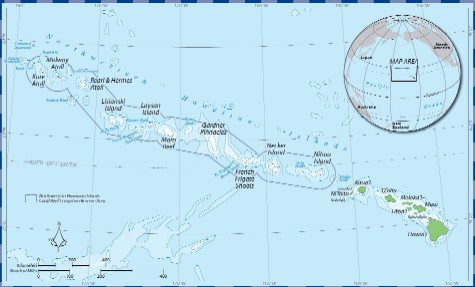 |
| NOAA Image of overview map of the Northwestern Hawaiian Islands Coral Reef Ecosystem Reserve |
The Northwestern Hawaiian Islands Marine National Monument encompasses nearly 140,000 square miles of U.S. waters, including 4,500 square miles of relatively undisturbed coral reef habitat that is home to more than 7,000 species. The monument will be managed by the Department of the Interior’s U.S. Fish and Wildlife Service and the Commerce Department’s National Oceanic and Atmospheric Administration, in close coordination with the State of Hawaii.
“Along with the two national wildlife refuges already in the area, this national monument provides permanent protection and conservation for the extraordinary natural resources and wildlife of the Northwestern Hawaiian Islands,” said Interior Secretary Dirk Kempthorne. “Relatively untouched by human activities, these isolated waters and coral reefs provide vital habitat for the endangered Hawaiian monk seal, the threatened Hawaiian green sea turtle and other rare marine species.”
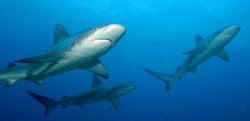 |
| Sharks and other large fish are common on most reefs throughout the Northwestern Hawaiian Islands, one of the few marine ecosystems remaining on the planet still dominated by apex predators. Photo NOAA |
“This is a landmark achievement for conservation, protection and enhancement of the Northwestern Hawaiian Islands,” said Commerce Secretary Carlos Gutierrez. “Approximately one quarter of the species here are found nowhere else in the world and a marine national monument will provide comprehensive, permanent protection to this region.”
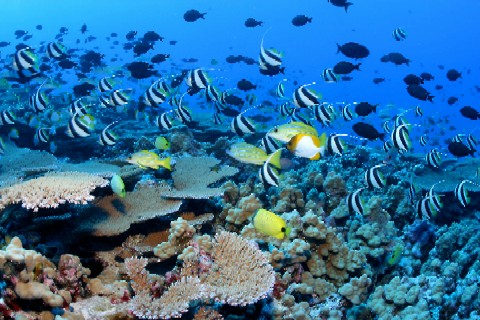 |
| Pennantfish, Pyramid and Milletseed butterflyfish—school in great numbers at Rapture Reef, French Frigate Shoals Photo NOAA |
The national monument is located in waters off the Hawaiian Islands Reservation established by President Theodore Roosevelt in 1909, the Hawaiian Islands National Wildlife Refuge and Midway Atoll National Wildlife Refuge, site of the key World War II sea battle and the Battle of Midway National Memorial.
Permits will be required for activities related to research, education, conservation and management, native Hawaiian practices and non-extractive special ocean uses.
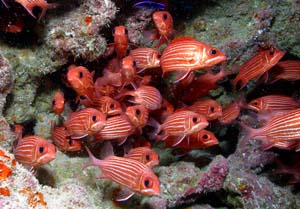 |
| Endemic Hawaiian squirrelfish can be seen schooling under ledges or table corals during the day. Photo NOAA |
The commercial and recreational harvest of precious coral, crustaceans and coral reef species will be prohibited in monument waters and commercial fishing in monument waters will be phased out over a five-year period. Oil, gas and mineral exploration and extraction will not be allowed anywhere in the monument.
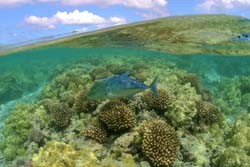 |
| The Northwestern Hawaiian Islands are home to more than 7,000 marine species, including the Bluefin Trevally. Photo NOAA |
Prior to today’s designation, this unique region had been part of a five-year study under a National Marine Sanctuary designation process, during which federal and state entities, native Hawaiian leaders and the public have participated in strong collaboration with significant amounts of testimony and input to develop a plan with broad-based consensus. Since 2000, more than 52,000 public comments were received, most supporting strong protection.
The President’s action means immediate protection, immediate implementation of the management measures included in the plan that was developed during the National Marine Sanctuary designation process, and immediate start of the "seamless" federal/state management process that will include ongoing consultation and involvement with the public.
Secretary Kempthorne noted that Hawaii Governor Linda Lingle recently approved the establishment of a marine refuge in the Northwestern Hawaiian Islands. “States and federal partners, national and local conservation organizations and thousands of interested individuals have made possible the protection of this national monument. This is collaboration at its best,” Kempthorne said.
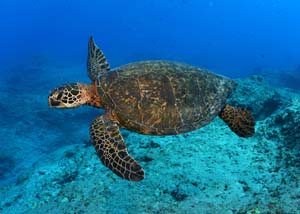 |
| More than 90 percent of all green sea turtles in Hawaii nest at French Frigate Shoals in the Northwestern Hawaiian Islands. Photo NOAA |
Under the Antiquities Act of 1906, which is celebrating its 100th year of enactment, the President of the United States is authorized to declare by public proclamation, historic landmarks, historic and prehistoric structures, and other objects of historic or scientific interest that are situated upon the lands owned or controlled by the Government of the United States to be national monuments.
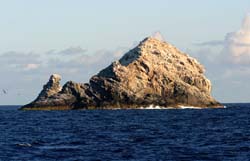 |
| The guano coated peaks of Gardner Pinnacles can be seen from the nearby waters of the reserve. Photo NOAA |
NOAA, an agency of the U.S. Department of Commerce, is dedicated to enhancing economic security and national safety through the prediction and research of weather and climate-related events and providing environmental stewardship of the nation's coastal and marine resources.
Through the emerging Global Earth Observation System of Systems (GEOSS), NOAA is working with its federal partners, 61 countries and the European Commission to develop a global network that is as integrated as the planet it observes, predicts and protects.
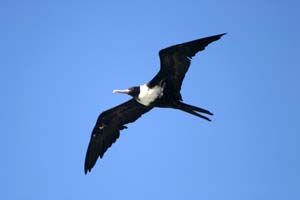 |
| Great frigate bird Photo NOAA |
Relevant Web Sites
NOAA Northwestern Hawaiian Islands Coral Reef Ecosystem Reserve
NOAA National Marine Sanctuary Program
NOAA Is Committed to Preserving the Northwestern Hawaiian Islands
Horizon's Magic Porthole Coral Reef Web Site
NOAA is solely responsible for the contents of this press release.
Search
Latest articles
Agriculture
- World Water Week: Healthy ecosystems essential to human health: from coronavirus to malnutrition Online session Wednesday 24 August 17:00-18:20
- World Water Week: Healthy ecosystems essential to human health: from coronavirus to malnutrition Online session Wednesday 24 August 17:00-18:20
Air Pollution
- "Water and Sanitation-Related Diseases and the Changing Environment: Challenges, Interventions, and Preventive Measures" Volume 2 Is Now Available
- Global Innovation Exchange Co-Created by Horizon International, USAID, Bill and Melinda Gates Foundation and Others
Biodiversity
- It is time for international mobilization against climate change
- World Water Week: Healthy ecosystems essential to human health: from coronavirus to malnutrition Online session Wednesday 24 August 17:00-18:20
Desertification
- World Water Week: Healthy ecosystems essential to human health: from coronavirus to malnutrition Online session Wednesday 24 August 17:00-18:20
- UN Food Systems Summit Receives Over 1,200 Ideas to Help Meet Sustainable Development Goals
Endangered Species
- Mangrove Action Project Collaborates to Restore and Preserve Mangrove Ecosystems
- Coral Research in Palau offers a “Glimmer of Hope”
Energy
- Global Innovation Exchange Co-Created by Horizon International, USAID, Bill and Melinda Gates Foundation and Others
- Wildlife Preservation in Southeast Nova Scotia
Exhibits
- Global Innovation Exchange Co-Created by Horizon International, USAID, Bill and Melinda Gates Foundation and Others
- Coral Reefs
Forests
- NASA Satellites Reveal Major Shifts in Global Freshwater Updated June 2020
- Global Innovation Exchange Co-Created by Horizon International, USAID, Bill and Melinda Gates Foundation and Others
Global Climate Change
- It is time for international mobilization against climate change
- It is time for international mobilization against climate change
Global Health
- World Water Week: Healthy ecosystems essential to human health: from coronavirus to malnutrition Online session Wednesday 24 August 17:00-18:20
- More than 400 schoolgirls, family and teachers rescued from Afghanistan by small coalition
Industry
- "Water and Sanitation-Related Diseases and the Changing Environment: Challenges, Interventions, and Preventive Measures" Volume 2 Is Now Available
- Global Innovation Exchange Co-Created by Horizon International, USAID, Bill and Melinda Gates Foundation and Others
Natural Disaster Relief
- STOP ATTACKS ON HEALTH CARE IN UKRAINE
- Global Innovation Exchange Co-Created by Horizon International, USAID, Bill and Melinda Gates Foundation and Others
News and Special Reports
- World Water Week: Healthy ecosystems essential to human health: from coronavirus to malnutrition Online session Wednesday 24 August 17:00-18:20
- STOP ATTACKS ON HEALTH CARE IN UKRAINE
Oceans, Coral Reefs
- World Water Week: Healthy ecosystems essential to human health: from coronavirus to malnutrition Online session Wednesday 24 August 17:00-18:20
- Mangrove Action Project Collaborates to Restore and Preserve Mangrove Ecosystems
Pollution
- Zakaria Ouedraogo of Burkina Faso Produces Film “Nzoue Fiyen: Water Not Drinkable”
- "Water and Sanitation-Related Diseases and the Changing Environment: Challenges, Interventions, and Preventive Measures" Volume 2 Is Now Available
Population
- "Water and Sanitation-Related Diseases and the Changing Environment: Challenges, Interventions, and Preventive Measures" Volume 2 Is Now Available
- "Water and Sanitation-Related Diseases and the Changing Environment: Challenges, Interventions, and Preventive Measures" Volume 2 Is Now Available
Public Health
- Honouring the visionary behind India’s sanitation revolution
- Honouring the visionary behind India’s sanitation revolution
Rivers
- World Water Week: Healthy ecosystems essential to human health: from coronavirus to malnutrition Online session Wednesday 24 August 17:00-18:20
- Mangrove Action Project Collaborates to Restore and Preserve Mangrove Ecosystems
Sanitation
- Honouring the visionary behind India’s sanitation revolution
- Honouring the visionary behind India’s sanitation revolution
Toxic Chemicals
- "Water and Sanitation-Related Diseases and the Changing Environment: Challenges, Interventions, and Preventive Measures" Volume 2 Is Now Available
- Actions to Prevent Polluted Drinking Water in the United States
Transportation
- "Water and Sanitation-Related Diseases and the Changing Environment: Challenges, Interventions, and Preventive Measures" Volume 2 Is Now Available
- Urbanization Provides Opportunities for Transition to a Green Economy, Says New Report
Waste Management
- Honouring the visionary behind India’s sanitation revolution
- Honouring the visionary behind India’s sanitation revolution
Water
- Honouring the visionary behind India’s sanitation revolution
- Honouring the visionary behind India’s sanitation revolution
Water and Sanitation
- Honouring the visionary behind India’s sanitation revolution
- Honouring the visionary behind India’s sanitation revolution

